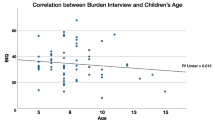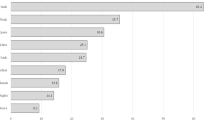Abstract
Purpose
The aim of this study was to investigate the relation between the physical problems of children with CP and caregiving burden and the emotional expression characteristics of caregivers.
Methods
The study included 144 caregivers of child with cerebral palsy and Zarit Burden Interview (ZBI) and Expressed Emotion Scale (EES) will be applied to the caregivers who will participate in the study. Disease severity of children with cerebral palsy will be evaluated by the Gross Motor Function Classification System (GMFCS) and Manual Ability Classification System (MACS) in children with cerebral palsy. Communication Function Classification System (CFCS) will be used to examine the communication of children with their families.
Results
Accordingly, a positive, statistically significant, moderate correlation was found between the GMFCS, MACS, and CFCS scores and ZBI scores in patients with cerebral palsy (r ~ 0.50; p < 0.01). In this study, a positive, statistically significant but weak correlation was found between GMFCS, MACS, and CFCS scores and EES scores in patients with cerebral palsy (r ~ 0.30; p < 0.01). A statistically significant, moderate correlation was found between ZBI and EES (r ~ 0.50; p < 0.01).
Conclusion
According to the results of our study, as motor skills and communication skills decrease, especially the burden of caregivers increases and the family’s emotional expression processes are related to these variables. We think that in the long-term follow-up of children with CP, it may be useful to provide appropriate psychiatric support by evaluating caregivers appropriately.
Similar content being viewed by others
References
Organization WH. World report on disability 2011: World Health Organization; 2011
Richards CL, Malouin F (2013) Cerebral palsy: definition, assessment and rehabilitation. Handb Clin Neurol 111:183–195
Serdaroǧlu A, Cansu A, Özkan S, Tezcan S (2006) Prevalence of cerebral palsy in Turkish children between the ages of 2 and 16 years. Dev Med Child Neurol 48(6):413–416
Ström H, Kreuter M, Rosberg S (2011) Quality of life in parents/caretakers of children with cerebral palsy in Kampong Cham, Cambodia. J Trop Pediatr 58(4):303–306
Khanna AK, Prabhakaran A, Patel P, Ganjiwale JD, Nimbalkar SM (2015) Social, psychological and financial burden on caregivers of children with chronic illness: a cross-sectional study. Indian J Pediatr 82(11):1006–1011
Zarit SH (2004) Family care and burden at the end of life. Cmaj 170(12):1811–1812
Atagün Mİ, Balaban ÖD, Atagün Z, Elagöz M, Özpolat AY (2011) Kronik hastalıklarda bakım veren yükü. Psikiyatride Güncel Yaklaşımlar 3(3):513–552
Ozlu A, Yildiz M, Aker T. (2009).Zarit Bakıcı Yük Ölçeğinin Şizofreni Hasta Yakınlarında Geçerlilik ve Güvenilirlik Çalışması. Archives of Neuropsychiatry/Noropsikiatri Arsivi;46
Kasuya RT, Polgar-Bailey MP, MPH Robbyn Takeuchi M. (2000) Caregiver burden and burnout a guide for primary care physicians. Postgraduate Med 108(7):119
Sarı HY. (2007).Zihinsel engelli çocuğu olan ailelerde aile yüklenmesi
Dokmen ZY. (2017).Yakınlarına bakım verenlerin ruh sağlıkları ile sosyal destek algıları arasındaki ilişkiler. Ankara Üniversitesi Sosyal Bilimler Dergisi;3(1)
Dattilio FM, Epstein NB (2015) Cognitive-behavioral couple and family therapy. Handbook of family therapy, Routledge, pp 103–133
Barrowclough C, Parle M (1997) Appraisal, psychological adjustment and expressed emotion in relatives of patients suffering from schizophrenia. Br J Psychiatry 171(1):26–30
Butzlaff RL, Hooley JM (1998) Expressed emotion and psychiatric relapse: a meta-analysis. Arch Gen Psychiatry 55(6):547–552
Zarit SH, Reever KE, Bach-Peterson J (1980) Relatives of the impaired elderly: correlates of feelings of burden. The Gerontologist 20(6):649–655
Cole JD, Kazarian SS (1988) The level of Expressed Emotion Scale: a new measure of expressed emotion. J Clin Psychol 44(3):392–397
Palisano R, Rosenbaum P, Walter S, Russell D, Wood E, Galuppi B (1997) Development and reliability of a system to classify gross motor function in children with cerebral palsy. Dev Med Child Neurol 39(4):214–223
Wood E, Rosenbaum P (2000) The Gross Motor Function Classification System for cerebral palsy: a study of reliability and stability over time. Dev Med Child Neurol 42(5):292–296
Eliasson A-C, Krumlinde-Sundholm L, Rösblad B, Beckung E, Arner M, Ohrvall AM, Rosenbaum P (2006) The Manual Ability Classification System (MACS) for children with cerebral palsy: scale development and evidence of validity and reliability. Dev Med Child Neurol 48(7):549–554
Akpinar P, Tezel CG, Eliasson A-C, Icagasioglu A (2010) Reliability and cross-cultural validation of the Turkish version of Manual Ability Classification System (MACS) for children with cerebral palsy. Disabil Rehabil 32(23):1910–1916
Hidecker MJC, Paneth N, Rosenbaum PL, Kent RD, Lillie J, Eulenberg JB, Chester K Jr, Johnson B, Michalsen L, Evatt M, Taylor K (2011) Developing and validating the communication function classification system for individuals with cerebral palsy. Dev Med Child Neurol 53(8):704–710
Mutlu A, Kaya-Kara O, Kerem-Gunel M, Livanelioglu A, Karahan S, Hidecker M (2013) Agreement between parents and clinicians for the communication function classification system (cfcs) of children with cerebral palsy: sp53. Dev Med Child Neurol 55:76
Sewell MD, Eastwood DM, Wimalasundera N (2014) Managing common symptoms of cerebral palsy in children. bmj 349:g5474
Yuan J, Wang J, Jieqiong M, Zhu D, Zhang Z, Jianan L (2019) Paediatric cerebral palsy prevalence and high-risk factors in Henan Province, Central China. J Rehabil Med 51(1):47–53
Raina P, O’Donnell M, Rosenbaum P et al (2005) The health and well-being of caregivers of children with cerebral palsy. Pediatrics 115(6):e626–ee36
Leff J, Vaughn C (1984) Expressed emotion in families: its significance for mental illness. Guilford press
Raune D, Kuipers E, Bebbington P (2004) Expressed emotion at first-episode psychosis: investigating a carer appraisal model. Br J Psychiatry 184(4):321–326
Guillamón N, Nieto R, Pousada M, Redolar D, Muñoz E, Hernández E, Boixadós M, Gómez-Zúñiga B (2013) Quality of life and mental health among parents of children with cerebral palsy: the influence of self-efficacy and coping strategies. J Clin Nurs 22(11–12):1579–1590
Hodge D, Hoffman CD, Sweeney DP (2011) Increased psychopathology in parents of children with autism: genetic liability or burden of caregiving? J Dev Phys Disabil 23(3):227–239
Can T. (2010).Bakas Caregiving Outcomes Scale'in (Bakas Bakım Verme Etki Ölçeği) Türkçe'ye uyarlanması, geçerlilik ve güvenirliliği
Stetz KM, Brown MA (1997) Taking care: caregiving to persons with cancer and AIDS. Cancer Nurs 20(1):12–22
Ones K, Yilmaz E, Cetinkaya B, Caglar N (2005) Assessment of the quality of life of mothers of children with cerebral palsy (primary caregivers). Neurorehabil Neural Repair 19(3):232–237
Yilmaz H, Erkin G, Nalbant L (2013) Depression and anxiety levels in mothers of children with cerebral palsy: a controlled study. Eur J Phys Rehabil Med 49(6):823–827
Eker L, Tüzün EH (2004) An evaluation of quality of life of mothers of children with cerebral palsy. Disabil Rehabil 26(23):1354–1359
Acknowledgements
The authors thank all the study participants and clinical staff who helped with this article.
Author information
Authors and Affiliations
Contributions
FY, ZAY, and EUA took part in the study design, conduct of the study, literature review and preparation of the article and conduct of the study. All authors have seen and approved the final draft. FY will act as guarantor for this post.
Corresponding author
Ethics declarations
Conflict of interest
The authors declare that they have no conflict of interest.
Additional information
Publisher’s note
Springer Nature remains neutral with regard to jurisdictional claims in published maps and institutional affiliations.
Rights and permissions
About this article
Cite this article
Yığman, F., Aykın Yığman, Z. & Ünlü Akyüz, E. Investigation of the relationship between disease severity, caregiver burden and emotional expression in caregivers of children with cerebral palsy. Ir J Med Sci 189, 1413–1419 (2020). https://doi.org/10.1007/s11845-020-02214-6
Received:
Accepted:
Published:
Issue Date:
DOI: https://doi.org/10.1007/s11845-020-02214-6




